September: How quickly our lovely summer flew by!
Frontenac State Park Association newsletter
September 2024 (Vol. 2, No. 9)
Questions, comments, compliments, complaints, contributions? Newsletter editor Pamela Miller is at pamelamarianmiller@gmail.com.
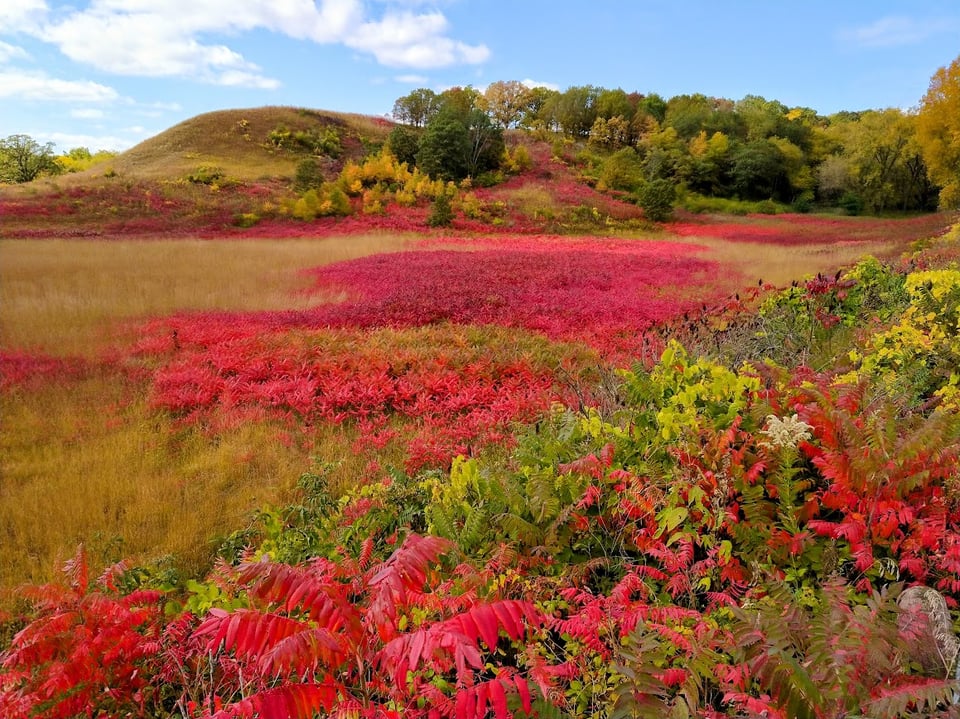
September: How quickly our lovely summer flew by!
And now, dear readers, commences September, that month of beautiful light and lengthening shadows, cooler days and longer nights. Along with May, it’s the favorite month of many Minnesotans who cite its heralding of a fresh, dramatic new season. And not surprisingly, it’s one of the most popular months to visit Frontenac State Park.
No day is a bad day for a walk in the park, especially in early fall. Always, there is beauty to behold, on your own or during activities supported by the Frontenac State Park Association.
Mark your calendars with our September and October events:
Sunday, Sept. 1, 11 a.m.-1 p.m.: The peregrine falcon has long fascinated us for its dramatic migration and amazing downward-spiraling hunting flight. Sixty years ago, there were none in the Upper Midwest. Today nearly 350 nesting pairs make their home here. Jackie Fallon, of the Midwest Peregrine Society, will present this program along with several falcons to help us understand their past, present and future in Frontenac State Park and the Upper Midwest. This free event will take place right next to the ranger station; you do need to have a state park pass, either daily or annual, if you drive into the park for it.
Saturday, Sept. 7, 10-11 a.m.: Nature walk with interpretive naturalist Bruce Ause, leaving from campground kiosk.
Tuesday, Sept. 10, 10-11 a.m.: Nature Explorers: Seeds, for preschoolers, with interpretive naturalist Sara Holger and FSPA helpers, main picnic shelter.
Saturday, Sept.14, 10-11 a.m.: Nature walk with interpretive naturalist Bruce Ause, leaving from campground kiosk.
Saturday, Sept. 21, 10-11 a.m.: Nature walk with interpretive naturalist Bruce Ause, leaving from campground kiosk.
Saturday, Sept. 28, 9-11 a.m.: Guided bird walk with FSPA members Janet Malotky and Steve Dietz, Sand Point Trail.
Saturday, Sept. 28, 10-11 a.m.: Nature walk with interpretive naturalist Bruce Ause, leaving from campground kiosk.
Saturday, Oct. 5, 10-11 a.m.: Nature walk with interpretive naturalist Bruce Ause, leaving from campground kiosk.
Tuesday, Oct. 8, 10-11 a.m.: Nature Explorers: Trees, for preschoolers, with interpretive naturalist Sara Holger and FSPA volunteers, main picnic shelter.
Saturday, Oct. 12, 9 a.m.-noon: Help us hand-collect native grass and wildflower seeds from a section of restored prairie in Frontenac State Park! The seeds you collect will later be planted in other areas of the prairie to restore the habitat and enhance biodiversity. No previous knowledge or experience is necessary, we will provide the tools and training.
Saturday, Oct. 12, 10-11 a.m.: Nature walk with interpretive naturalist Bruce Ause, leaving from campground kiosk.
Saturday, Oct. 12, noon-1 p.m.: Fungi habitat walk with FSPA member Pamela Miller, leaving from campground kiosk. We’ll hope to see a few beautiful maitake (hen of the woods) and other late risers. It all depends on rain. If there is no rain and thus no fungi, we will still have a lovely walk in the park!
Saturday, Oct. 19, 10-11 a.m.: Nature walk with interpretive naturalist Bruce Ause, leaving from campground kiosk. (Last one of 2024.)
Saturday, Oct. 19, 9 a.m.-11 am: Guided bird walk with FSPA members Janet Malotky and Steve Dietz, leaving from campground kiosk.


Play in the wild: Bring your little ones to our park’s natural playground
Just southwest of the park overlook’s parking lot, you’ll find a natural-materials playground that will delight your little ones (you grown-ups will enjoy it too). Here are a couple of photos. Check it out!
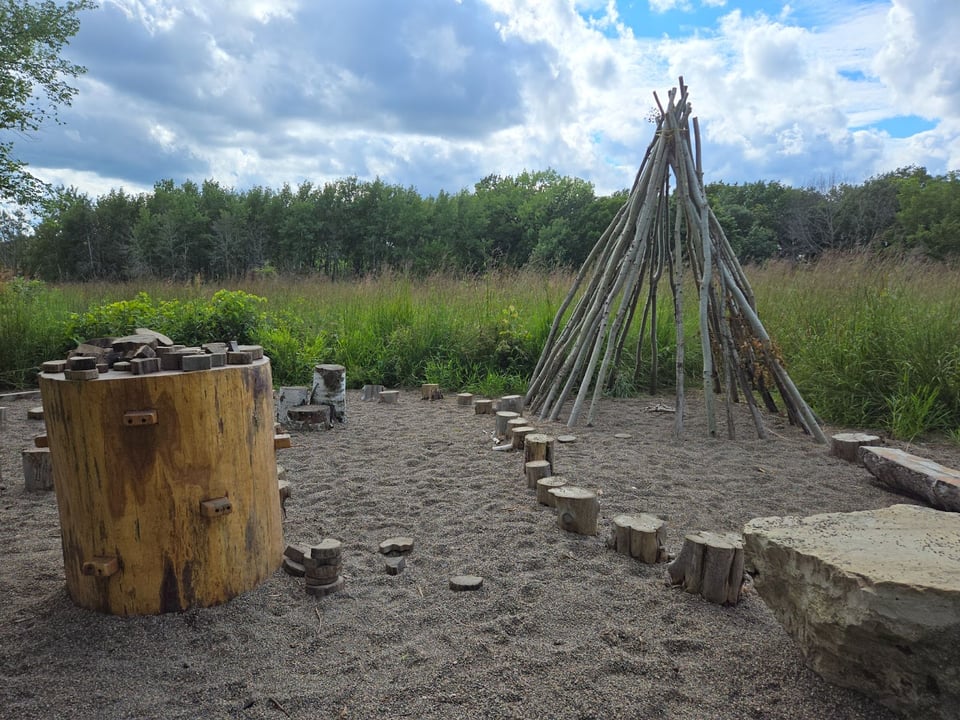

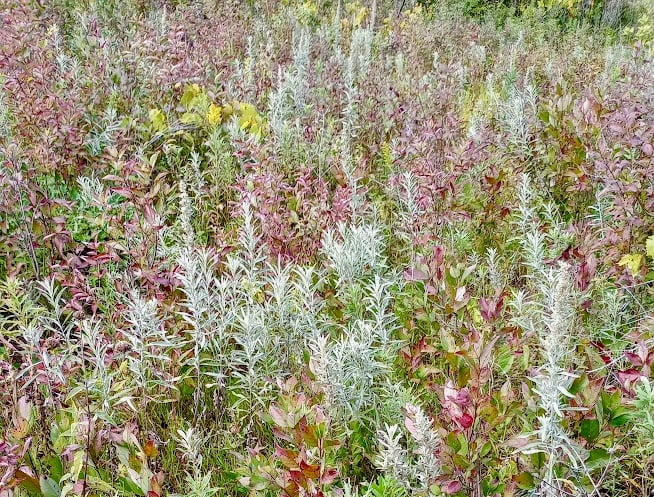
Our sign is the very, very, very best sign
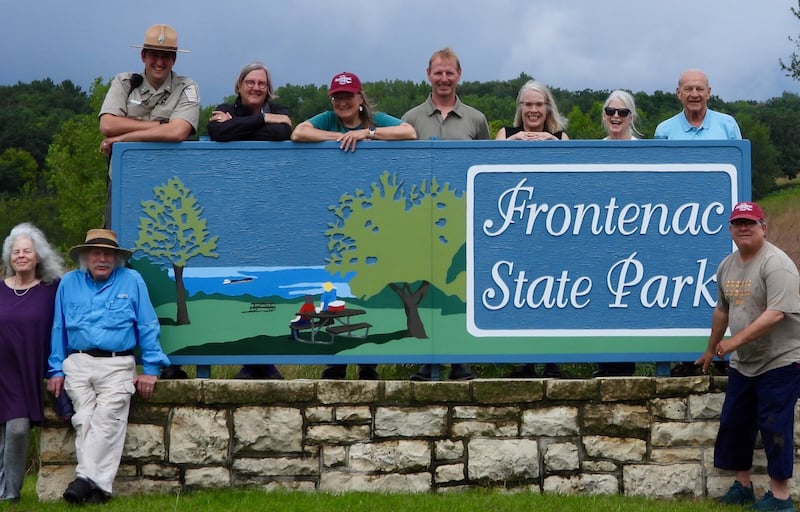
Usually, when you drive into a Minnesota state park, you’re welcomed by a sturdy brown sign with gold lettering. We’re good with that—nothing wrong with those dignified workhorses.
But … Frontenac State Park is special! We’ve long had a beautiful, colorful painted entrance sign, but last year, it keeled over from wear and tear. Behold—we have a brand new one!
Some of the FSPA members who helped our park purchase this unique sign recently posed for the photo above, clambering all over it like giddy kids as they cracked ridiculous jokes. From left, they are: Kristen Eide-Tollefson, Ted Tollefson, park manager Jake Gaster, Janet Malotky, Pamela Miller, Dean Potter, Rachael O’Donnell, Susan Wandmacher, Wayne Wandmacher and Steve Dietz, who snapped this photograph and then raced back to the sign so he’d be in the photo too. Thanks to all of you and the rest of FSPA for making our special sign possible!
“Small but mighty” and “not annoying”: That’s … us!
Indulge us as we report this news nugget … in August, the venerable Parks & Trails Council of Minnesota named us, your friendly Frontenac State Park Association, the top Minnesota park friends’ group of 2024, an award that came with $500 for our projects. You could have knocked us over with a feather! (Well, to be honest, you can USUALLY do that, given our general wooziness, but this was entirely unexpected!)
When park manager Jake Gaster announced the award at our quarterly meeting in August, he said he was delighted that we were honored because we’re so very “not annoying.” (THANKS, JAKE! We’ll try to up our game there! But, seriously, we understand what he meant–we’re here to help, not pontificate, kvetch or second-guess.)
Here’s what Parks & Trails wrote about us (edited for brevity):
Small but mighty: Celebrating the FSPA
The Frontenac State Park Association, founded in 1956, predates the park itself. Initially formed to advocate for establishment of the park, the group continues its go-getter tradition to this day. It’s led speedy and successful habitat restoration projects, organized well-attended candlelight walks, and promoted citizen engagement birding events, bio-blitzes, and educational talks on topics such as native mussels and park ecology. In the last two years alone, the FSPA has restored native trees at the park’s campground, carried out a habitat restoration near a wildlife blind, and thrown two well-attended winter candlelight events.
In recognition, Parks & Trails Council proudly presents the FSPA with its annual Friends Group Partner Award. The award will be presented during our Annual Shindig on Sept. 19, and includes a $500 award.
“I cannot be more in support of this nomination,” said park manager Jake Gaster. “They are passionate and dedicated and have achieved much in the past couple years. They are wonderful to work with!”
The FSPA has contended with obstacles. Recruiting a core team of board members has been difficult at times, a situation many volunteer-led groups will be familiar with. As a small organization, it has at times found it difficult to leverage as many volunteers as it would like for its ambitious projects.
But what the FSPA lacks in numbers, it makes up for in enthusiasm. When Parks & Trails representatives attended its May 2024 habitat restoration event, they found a group that operated like a well-oiled machine. FSPA members organized themselves so efficiently that the work of planting dogwood, butterfly weed and native grass cover took half of the anticipated time, and participants got the satisfaction of a job well done without excessive exhaustion or more than the usual amount of mosquito bites.
All volunteer groups know the pain of recruiting enough people to accomplish their missions. The Frontenac State Park Association serves as a sterling example of what can be accomplished when even a small group of committed and passionate community members come together around a common goal. We look forward to what they will do with that passion in the coming years!
Wow! We had no idea we were so awesome! Go, us!
But enough of that!
What you, and we, REALLY want to read about is the park itself. To that end, here’s our favorite park manager’s report on how things are going.
Reports Jake Gaster:
This has been an unusual year, moisture-wise. With heavy rains well into the summer, we have observed some unusual patterns on the landscape. One notable difference from the past few years is the relative abundance of grasses in our prairies. During the past few years, Indiangrass (Sorghastrum nutans) has been the dominant grass across our prairies, with smaller areas and patches dominated by big bluestem (Andropogon gerardii) interspersed among the Indiangrass. This year, it is the opposite. The bluestem colors the prairies a lovely, deep maroon, tinged with blue, as opposed to the lighter tan of the feathery seed heads of Indiangrass. Also, as the bluestem can grow to 7 or 8 feet tall, the prairies are particularly lovely to get lost in this year. Another interesting observation is that some of our spring/early summer wildflowers (such as compass plant and butterfly weed) did a second bloom in late July and early August, thanks largely to mild temperatures and abundant precipitation.
Paddocked goats continue to be successfully used to fight buckthorn in the Rattlesnake Bluff area. However, uh … one is on the loose, having escaped last year and survived the winter. (He’s been spotted a couple of times this year.) Now THAT goat is a REAL G.O.A.T. (Greatest Of All Time) goat! Here’s the best part: His name is White Lightning. If you see him, snap a photo and report the sighting to park HQ.
Park visitor attendance is high for the year so far, helped by a busier-than-normal winter and mild spring/early summer. Attendance numbers year-to-date are higher than any outside of the COVID-19 era. Here’s a graphic to illustrate:
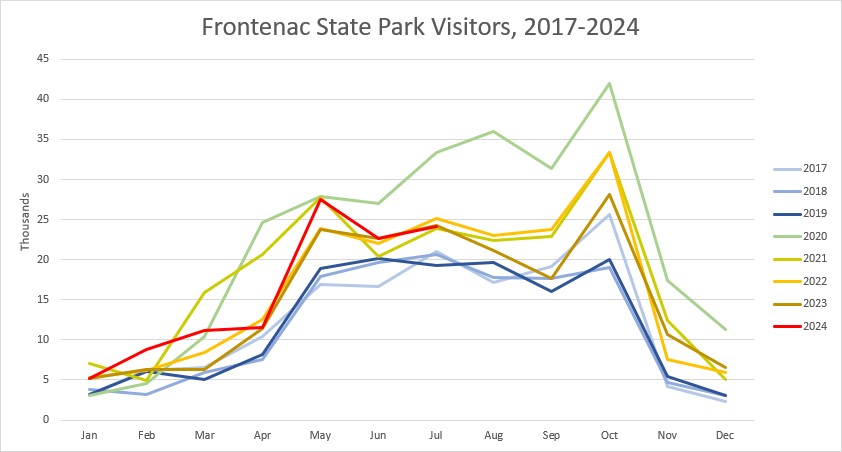
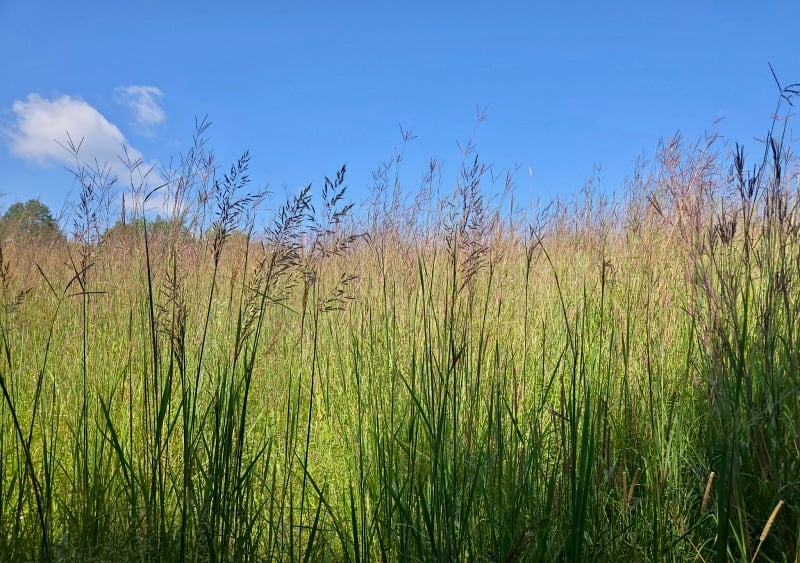

Everywhere you look, there’s a rabbit. Or four.
By Pamela Miller, Minnesota Master Naturalist volunteer
What’s with all these WASCALLY WABBITS? Like Elmer Fudd, whom many members of your Frontenac State Park Association closely resemble, we’ve asked that question, and often heard it asked by our neighbors, since this past spring, as Frontenac State Park visitors and those of us who live near the park almost trip over eastern cottontails (Sylvilagus floridanus), which serve, quite frankly, as the potato chips of the wild.
It appears that our mild winter and spring led to a proliferation of cottontails, not that they’re that scarce in normal circumstances.
Everything feasts on cottontails: coyotes, foxes, owls, hawks, rattlesnakes, weasels, raccoons, dogs and cats. The cottontail is a silent animal except for that hair-raising high-pitched shriek it makes when it’s about to become a meal. Ouch—even those of us who tear our hair out after rabbits devour our garden plants wince when we hear that sound late at night.
So it goes, in nature. Cottontails eat every plant in sight, and in turn, every carnivore eats them.
Curious to learn more about this little animal we all think we know well, we turned to the Minnesota Department of Natural Resources. Some facts about the eastern cottontail, courtesy of the DNR:
It’s a rabbit, not a hare. (There are hares in Minnesota—the white-tailed jackrabbit and the snowshoe hare.)
Rabbits’ reputation as speedy breeders is well-earned. A female that gives birth to a litter of four to six young can be bred again within hours, and give birth to the new litter just three weeks later.
A newborn cottontail weighs about an ounce at birth and is hairless and sightless. It leaves its well-hidden nests, dug by its mother, often concealed in brush piles in your yard (yes, yours), after about three weeks.
Cottontails eat green plants, twigs, bark and sometimes, (wow, this is weird,) their own vitamin-rich droppings. In the summer they feed on grass and clover. In the winter they eat twigs and bark.
Cottontail hunting is popular in Minnesota. In fact, cottontails are the No. 1 game animal in the United States, the DNR tells us. Each year about 80 percent of Minnesota's cottontail population is killed by harsh weather, predators or disease. But don’t be alarmed: The remaining 20 percent have little trouble repopulating the landscape.
It can be tempting to pick up a cute baby rabbit, especially if you want to show it to a curious child, but, uh, don’t. They terrify easily, and terror can kill them. In addition, cottontails sometimes carry diseases, including zoonotic ones such as pasteurellosis, ringworm, mycobacteriosis, cryptosporidiosis and external parasites.
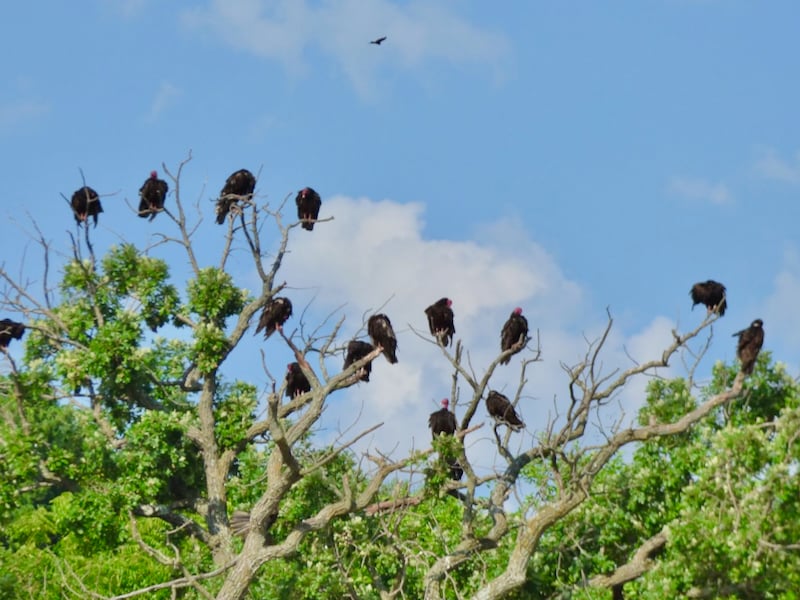
Bird note: Bittersweet fall
By Janet Malotky, Minnesota Master Naturalist volunteer
August and September have a lot to offer bird watchers. The humidity eases and cool, crisp mornings are ideal for strolling through the park with a pair of binoculars. Many baby birds have fledged and are trying out their songs with wobbly voices. Where one or two Baltimore Orioles used to be, there is now a rowdy crowd of five or six. Young, scruffy-looking Downy Woodpeckers crowd the suet and hummingbirds guard “their” nectar against increasing competition.
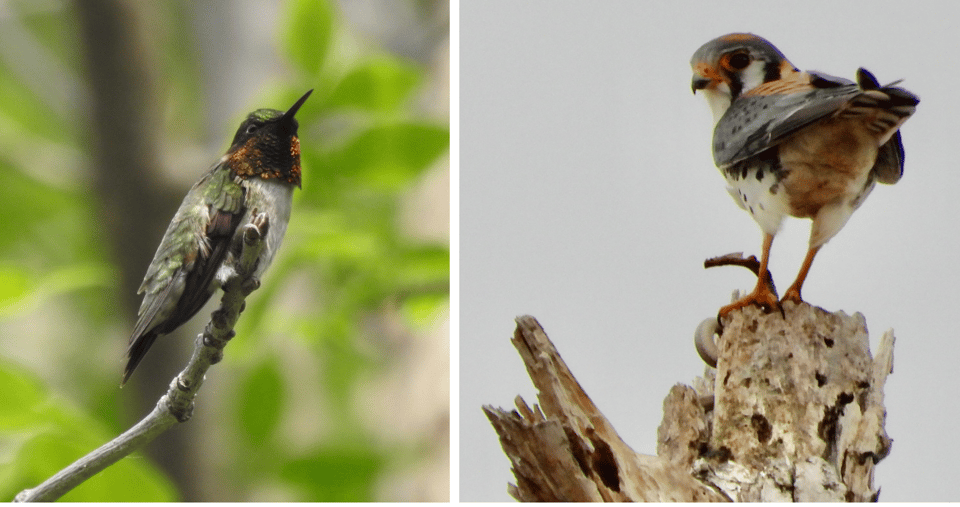
But there’s a bittersweet undertow to these months. One day walking the prairie, you notice that there are no meadowlarks singing and you haven’t seen one on the County 2 telephone wires all week. The fledgling kestrels who patrolled the tall grass are not perched in their familiar tree. The Orchard Orioles have gone quiet. Alas—it’s fall migration time and the birds are beginning to head south. Suddenly it seems they are just gone. And they don’t even say goodbye.
At the time of this writing in late August, we are no longer hearing Yellow Warblers, Dickcissels, Rose-breasted Grosbeaks, Yellow-throated Vireos, Common Yellowthroats, Clay-colored Sparrows, Prothonotary Warblers or Lark Sparrows, to name just a few, in addition to the aforementioned meadowlarks, kestrels, and orioles. There are far fewer Red-winged Blackbirds hanging around the beaver pond at Sand Point, almost no Tree Swallows swooping the prairie, and no Cliff Swallows diving under the Wells Creek Bridge. I try to imagine them winging their way to warmth, but I feel a little tug of loss and sense the distant chill of approaching winter.
What’s the upside, though? Because when it comes to birds, there’s always an upside.
Well, yesterday I saw a Spotted Sandpiper at the beaver pond, which was also dotted with Blue-winged Teal. Shorebirds are on their way and so are the ducks and the northern-breeding warblers! In the next several weeks, we have a chance of seeing American Avocets, Solitary Sandpipers, assorted plovers, Sanderlings, Dunlin, and then the Tundra Swans. The Blackburnian and Magnolia Warblers we spied in May might even be back through, along with their little buddies, the Canada, Golden-winged, and Chestnut-sided Warblers. And don’t forget the kinglets! This is going to be fun!


Mushroom of the month: The lobster
Walking along a Frontenac State Park trail in August or early September, you may spot a bright orange, thick, dirt-speckled mushroom or three off to the side. These are lobster mushrooms, highly edible (if you get them fresh and can clean them off enough), one of the strangest growths on Earth.
The lobster mushroom’s firm red exterior is formed when the Hypomyces parasite infects a host mushroom (Russula or Lactarius species, neither one edible) and turns it into something else entirely—completely different in appearance and safe, in fact desirable, to eat. As our Minnesota mushroom bible (“Mushrooms of the Upper Midwest” by Teresa Marrone and Kathy Yerich) notes, “Some lobsters taste like seafood, while others are bland; some may be peppery. Lobster mushrooms should be fresh and firm; they should not be eaten when they are old and soft or if they lack the bright orange, pimply surface.” Watch for them, verify them, and give them a try.
Notes from the Field: Milbert’s Tortoiseshell
By Steve Dietz, Minnesota Master Naturalist volunteer
As many readers will know by now, observations from within Frontenac State Park boundaries that are posted to the citizen science project iNaturalist become part of our Frontenac State Park project. It’s fun to peruse this site and see what others have seen in the park, either recently or over the years.
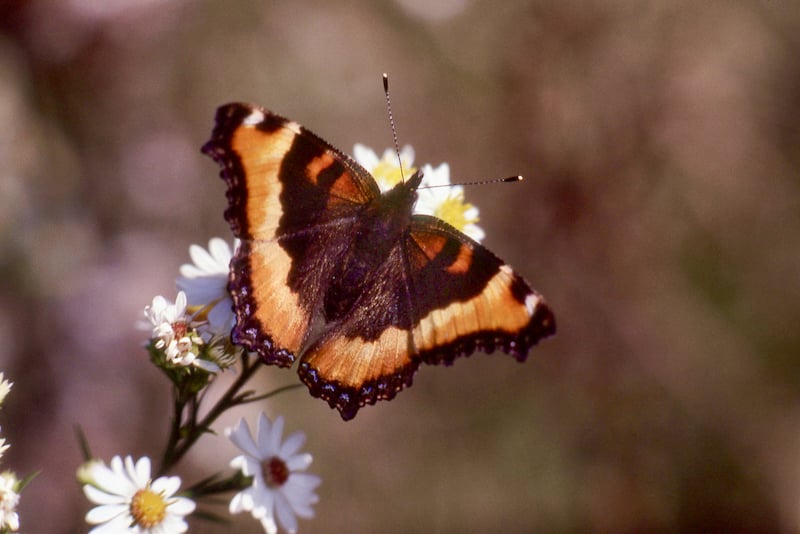
For instance, the only recorded sighting of a Milbert’s Tortoiseshell in the park was on September 23, 1977 by Kenneth Haier. Why has there only been one recorded sighting? According to Minnesota Seasons the butterfly is not listed (endangered) in Minnesota and its known range includes Goodhue County. On the other hand, Aglais milberti is the only known species of its genus in North America! And its only larva host in Minnesota is the American stinging nettle - and we know there are plenty of those in the park.
In any case, thank you to Mr. Haier for this month’s Note from the Field. We’d love to have your sightings in the park on iNaturalist as well.
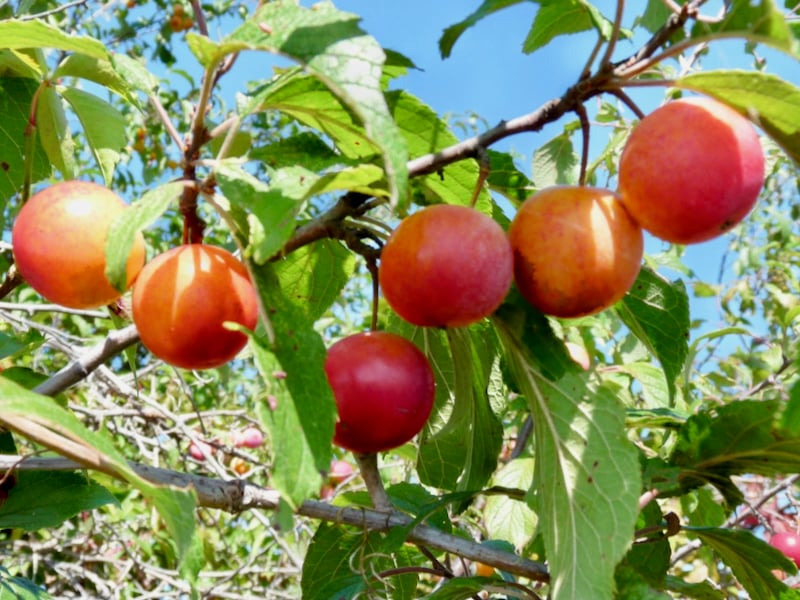

Poem of the month
“A BLESSING”
By James Wright (Minnesotan; 1927-1980)
Just off the highway to Rochester, Minnesota,
Twilight bounds softly forth on the grass.
And the eyes of those two Indian ponies
Darken with kindness.
They have come gladly out of the willows
To welcome my friend and me.
We step over the barbed wire into the pasture
Where they have been grazing all day, alone.
They ripple tensely, they can hardly contain their happiness
That we have come.
They bow shyly as wet swans. They love each other.
There is no loneliness like theirs.
At home once more,
They begin munching the young tufts of spring in the darkness.
I would like to hold the slenderer one in my arms,
For she has walked over to me
And nuzzled my left hand.
She is black and white,
Her mane falls wild on her forehead,
And the light breeze moves me to caress her long ear
That is delicate as the skin over a girl's wrist.
Suddenly I realize
That if I stepped out of my body I would break
Into blossom.
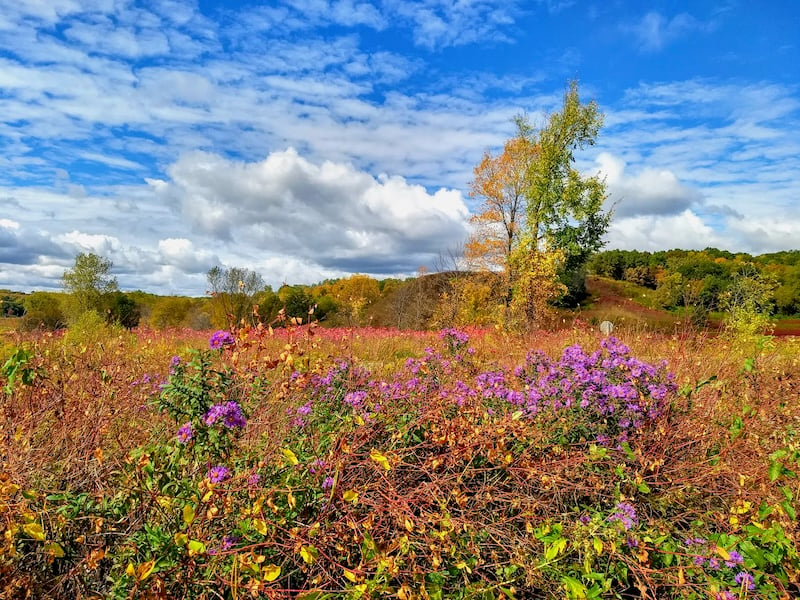
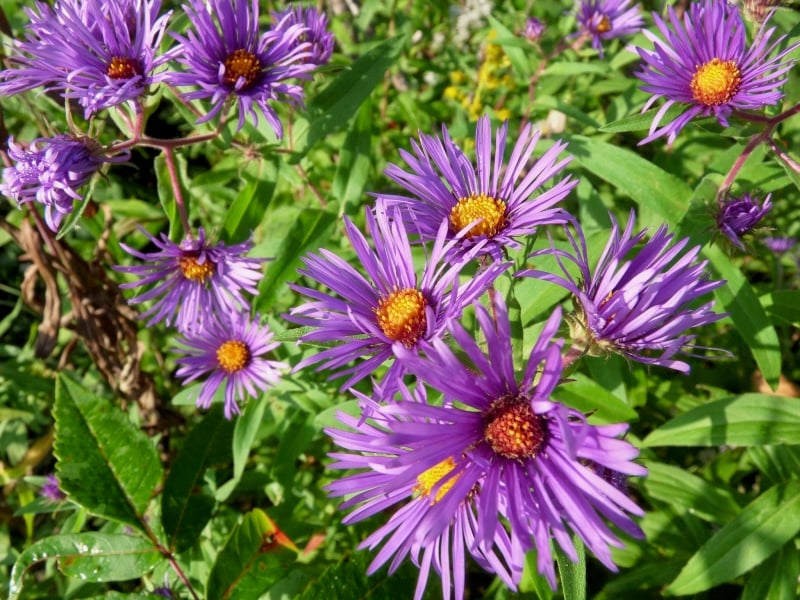
Interested in joining the FSPA?
We’d be honored to have your support. Dues are $25 per year for an individual, $35 for dual/family membership. Here’s a link with signup information.
A reminder that joining us occasionally to help with volunteer efforts is awesome too, even if you’re not a member. The FSPA’s goal is simply to share our love of Frontenac State Park with as many people as possible.
To sign up to regularly receive this free and gloriously spam-free monthly newsletter, click on “Subscribe” below. Feel free to send questions or comments to your newsletter editor at pamelamarianmiller@gmail.com. Questions about the FSPA? You can reach hard-working FSPA chair Steve Dietz at stevedietz@duck.com.

Handy links for more information and education
Frontenac State Park website
Frontenac State Park Association website
If you take pictures in the park, tag us on Instagram
Frontenac State Park bird checklist
Frontenac State Park on iNaturalist
Website for our township, Florence Township
Minnesota Master Naturalist program
Red Wing Environmental Learning Center
Lake City Environmental Learning Program on FB
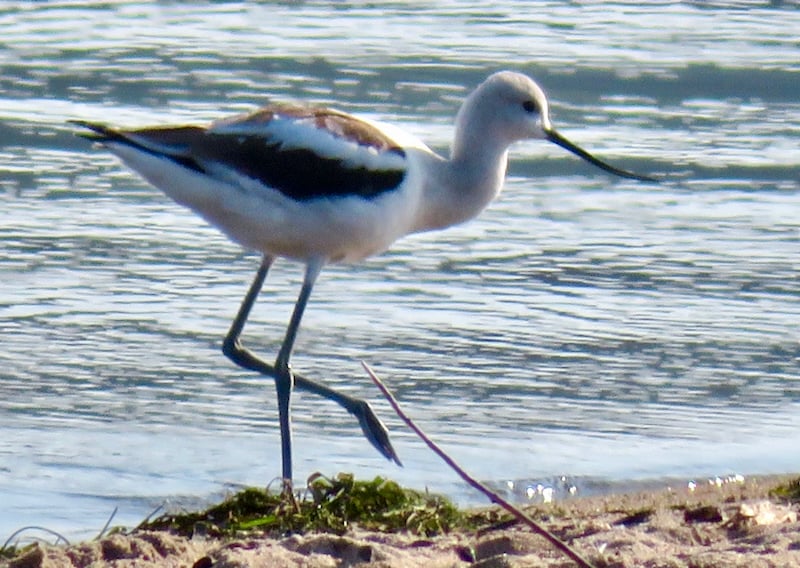
Frontenac State Park staff
Jake Gaster, park manager; Amy Jay, assistant park manager; Amy Poss, lead field worker
Parting shots
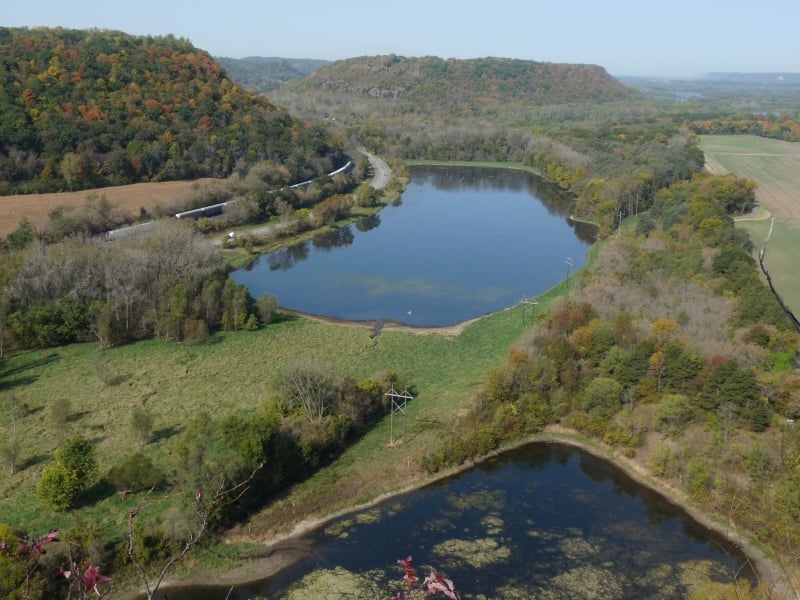


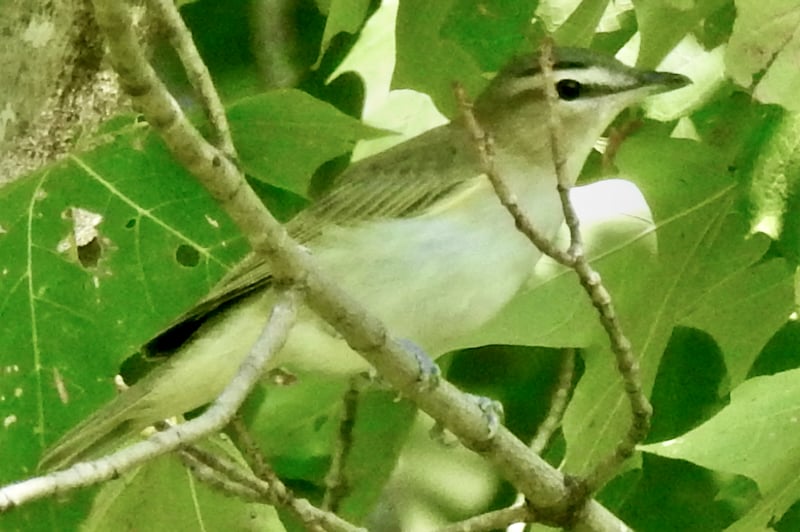
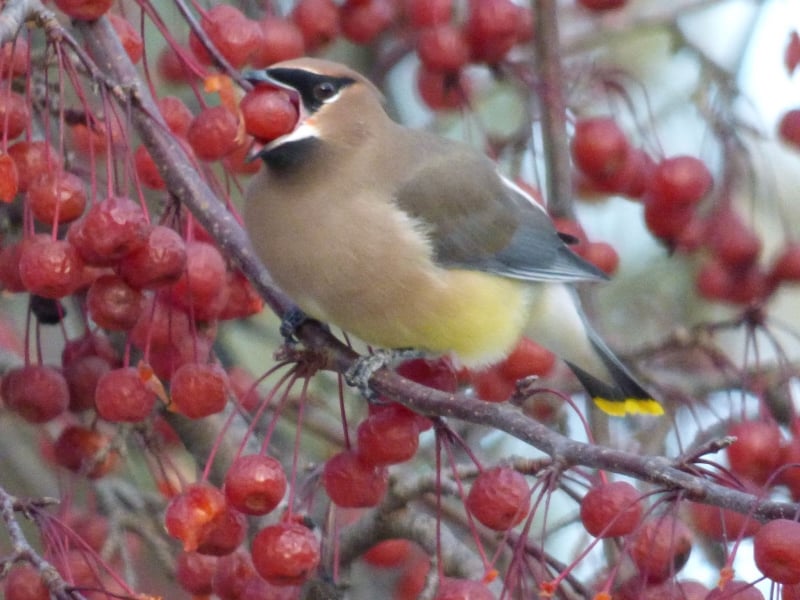
Thank you, readers and park visitors!
This is Volume 2, No. 9 of the Frontenac State Park Association newsletter, which was launched in April 2023.
Here’s where to browse the full archives of this newsletter.